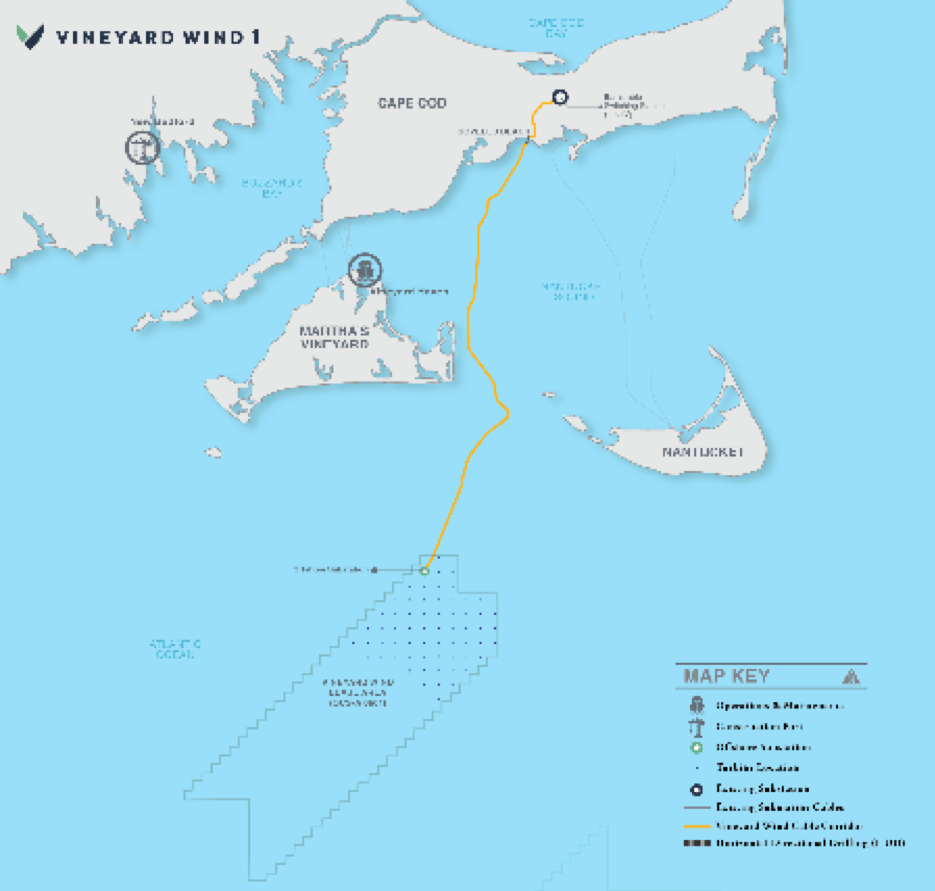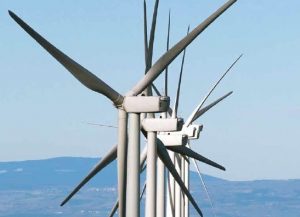 Vineyard Wind, a joint venture between Avangrid Renewables, a subsidiary of AVANGRID, Inc., and Copenhagen Infrastructure Partners, received the Record of Decision (ROD) from the U.S. Department of the Interior Bureau of Ocean Energy Management (BOEM), the final major step in the federal review process for the first commercial scale offshore wind farm in the United States.
Vineyard Wind, a joint venture between Avangrid Renewables, a subsidiary of AVANGRID, Inc., and Copenhagen Infrastructure Partners, received the Record of Decision (ROD) from the U.S. Department of the Interior Bureau of Ocean Energy Management (BOEM), the final major step in the federal review process for the first commercial scale offshore wind farm in the United States.
“Today’s Record of Decision is not about the start of a single project, but the launch of a new industry,” said Vineyard Wind CEO Lars T. Pedersen. “Receiving this final major federal approval means the jobs, economic benefits, and clean-energy revolution associated with the Vineyard Wind 1 project can finally come to fruition. It’s been a long road to get to this point, but ultimately, we are reaching the end of this process with the strongest possible project. I want to thank the Biden Administration, Secretaries Haaland and Raimondo, and BOEM for their efforts in finalizing the review of this project. I also want to thank Governor (Charlie) Baker, the Massachusetts federal delegation and State Legislature for their steadfast commitment to seeing this endeavor through to today. And of course, I want to extend my sincerest appreciation to all our supporters and stakeholders for all of their work, input, and dedication. We could not have reached this milestone without you.”
“We are very excited and proud to be part of the birth of an incredibly important new industry the U.S. Offshore wind is a key part of America’s clean energy future, and Vineyard Wind 1 is a major step forward to the clean and connected future we envision and work toward every day,” said AVANGRID CEO Dennis V. Arriola. “We appreciate the thorough review by BOEM as well as the considerable input from stakeholders. The broad engagement from many parties throughout this process has improved the project and positioned both Vineyard Wind 1 and the broader offshore wind industry for long-term success.”
“We are very proud to have been part of developing this landmark project,” said Christian T. Skakkebæk, a senior partner and co-founder of CIP. “Vineyard Wind 1 is slated to become one of the world’s largest offshore wind projects, creating significant investments and good paying jobs in the U.S. For many years we have been actively engaged in the development of the U.S. offshore wind market, and we are confident that Vineyard Wind will pave the way for a successful and growing wind industry in the country. This market will play an important role for CIP’s renewable investments for years to come, and we look forward to being an integral part in the transition to green energy in the U.S.”
“Massachusetts should be proud that this decision launches the nation’s first commercial-scale offshore wind project here on the Commonwealth’s shores,” said Gov. Charlie Baker. “This groundbreaking project will produce affordable, renewable energy, create jobs, and prove Massachusetts developed a successful model for developing offshore wind energy. We appreciate the federal government’s partnership to grant this approval and look forward to working with Vineyard Wind to create thousands of jobs and set the Commonwealth on a path to achieve Net Zero emissions.”
“Today’s approval of the Vineyard Wind offshore project is a key step toward achieving the Biden Administration’s goal of bringing 30 GW of offshore wind online by 2030, and GE is excited to support that goal by providing our Haliade-X turbines, the most powerful offshore wind turbine built to date, for this project,” said John Lavelle, president and CEO, Offshore Wind at GE Renewable Energy. “Today’s decision is one more reason to be optimistic about the potential of offshore wind in the US, an abundant source of clean, renewable energy that can help coastal communities address the threat of climate change and accelerate the energy transition.”
Since 2017, the Vineyard Wind 1 project has been through an unprecedented and exhaustive public review process that generated more than 30,000 public comments, more than 90 percent of which supported the project. The Construction and Operations Plan (COP) was reviewed by more than two dozen federal, state, and local agencies over the course of more than three and a half years.
The project design includes the world’s most powerful wind turbine, the GE Haliade-X, with a capacity of 13 MW. The larger turbine capacity has allowed the project to reduce the total number of turbines from 108 to 62 while still delivering a total capacity of 800 MW to Massachusetts ratepayers. The turbine layout, which features consistent spacing of one nautical mile between turbines, was endorsed by the United States Coast Guard for transit, fishing, and navigational safety.
“With this record of decision on Vineyard Wind on the books, the era of American offshore wind is no longer on the horizon — it’s here, now, off the coast of Massachusetts, and the answer to America’s energy future is blowing in the offshore wind,” said U.S. Sen. Edward Markey. “Vineyard Wind will be the first of many offshore wind projects to come, and we can use our Bay State know-how to show the rest of the country how to get steel in the water, zero-emission energy on the grid, and union jobs to American workers. I applaud Vineyard Wind, Massachusetts stakeholders, and the Biden administration for moving forward with this project and following through on their commitment to jobs, climate, and American innovation.”
“Today’s Record of Decision for Vineyard Wind is great news for Massachusetts and our country,” said U.S. Sen. Elizabeth Warren. “The Vineyard Wind project will generate clean energy for Massachusetts families and businesses, create thousands of good jobs, and is a bold step forward toward fighting the climate crisis. I will keep working with the Biden Administration, my delegation colleagues, local stakeholders, and Vineyard Wind to move this project forward and help make Massachusetts a leader in our clean energy future.”
In response to comments and direct engagement with neighboring communities, environmental organizations and advocates, fisheries organizations, and governmental and tribal entities, the project has incorporated significant mitigation measures, including:
Historic Protections for the North Atlantic Right Whale (NARW)
- Commitment to invest millions of dollars to develop and deploy innovative technologies and undertake scientific research to further safeguard marine mammals. Last year, Vineyard Wind partnered with Greentown Labs to work with the startup community to innovative technologies to the forefront. To learn more about that initiative, click here.
- Institute comprehensive monitoring protocols to ensure that construction doesn’t take place when NARWs are near the lease area. The project will use acoustic monitoring technology throughout construction including in transit corridors and will employ trained protective species observers to spot NARW visually during transits and foundation installation.
- Deploy industry leading technology to dampen construction noise during installation in order to protect the NARW and all marine species.
Substantial Fisheries Investment and Mitigation Funding
- Agreements with the states of Massachusetts and Rhode Island to provide millions to compensate fishermen for potential loss of revenue and gear and to enhance their ability to fish in and around the lease area.
- Commitment to continue funding pre- and post-construction survey studies with both the University of Massachusetts Dartmouth School for Marine Science and Technology (SMAST) and the Massachusetts Lobstermen’s Association (MLA) to measure what impact, if any, the windfarm is having on the marine environment. To learn more about the fisheries studies, click here.
Cultural and Historical Protections
- Project will use an aircraft detection lighting system (ALDS) to ensure that nighttime lights will only operate a few hours a year when aircrafts are present.
- Turbines will be painted to reduce visual impacts to historical properties.
- Funds will be allocated to conduct ethnographic studies for local Native American Tribes that will serve as the basis for submissions to the National Register of Historic Places to allow for greater recognition of tribal heritage sites.
Vineyard Wind 1 is an 800 MW project 15 miles off the coast of Martha’s Vineyard and will be the first commercial scale offshore wind project in the United States. The project will generate electricity for more than 400,000 homes and businesses in the Commonwealth of Massachusetts, create 3,600 full-time equivalent (FTE) job years over the life of the project, save ratepayers $1.4 billion over the first 20 years of operation and is expected to reduce carbon emissions by more than 1.6 million tons per year.
Vineyard Wind will reach financial close in the second half of 2021 and begin delivering clean energy to Massachusetts in 2023.
More info: www.vineyardwind.com



























